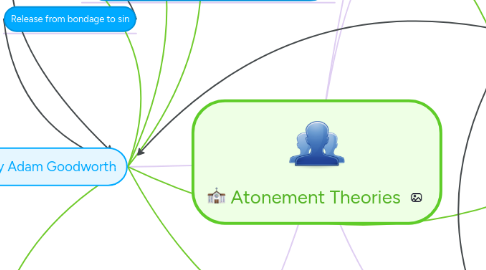
1. Satisfying God's righteousness
2. Victory over Satan
3. Making humanity "right" with God
4. Over Satan
5. Over Humanity
6. Christus Victor by Adam Goodworth
6.1. First developed by Iranaeus in the mid-second century in response to Gnosticism
6.1.1. The early Church was challenged intellectually by the Gnostics on the grounds of a divine God, becoming man. They believed this was impossible, since the flesh was so sinful, they also called Christ an illusion. Iranaeus, learnt the error in their theories and presents the ‘classic theory’
6.2. Salvation is made possible through Christ overcoming Satan
6.2.1. Made possible, not through violence, bondage, or enmity, but according to God's justice and righteousness, Aulen calls it Persuasion. Where Satan thought he had killed Christ, but was later defeated and stripped of his power.
6.2.1.1. The stripping of these powers, means that Humanity is now freed from the bondage of sin and death, and can now live according to the Life that God originally designed humanity for.
6.2.1.1.1. This theory has been criticized and labeled Divine Child Abuse, for it has been taught, in order to receive victory, one must endure pain and suffering as Christ did before gaining victory. This entraps people psychologically into thinking they have to endure things, when they don't. Such as women in abusive marriages etc....
6.2.1.1.2. Aulen comments on the emphasis of death over sin, but highlights that it was through original sin that brought death. But through Christ’s obedience, we are now at one with God.
6.3. Most popular doctrine of Atonement for the first 1000 years of the Church
6.3.1. Some argue that this theory is gaining more popularity to the younger generations, especially those who have a fascination with witch craft, diabolical forces and animism (emphasizing the triumphant victory of Christ over Satan through the cross)
6.3.1.1. Others argue that a more mature understanding and theory is required for those who have been believers for a long time.
7. Moral Influence
8. Scapegoat
9. Eradicates Sin (deals with the problem of sin not just it's consequences)
10. Concerned with Justice
11. Influence/Persuasion
12. Release from bondage to sin
13. Debt/penalty of sin
14. Debt of honour against God
15. Representative of humanity
16. Born out of the Love of God for humanity
17. Concerned with reconciliation with God
18. Penal Substitution
18.1. Became popular during the Reformation and remains popular with Evangelicals
18.1.1. Has become an emotionally contentious theory with some theologians arguing that those who do not agree with it are likely not true believers
18.2. Promotes the idea that assurance of Salvation is found only through satisfaction of retributive justice (ie turning away the wrath of God by payment of an appropriate penalty for sin)
18.2.1. Argues that all other theories and models about atonement should be interpreted through this one.
18.3. Theological criticism includes the challenge that this theory is the result of using Western judicial systems (retributive justice) to reinterpret biblical judicial systems (restorative justice). Other theological criticism is that it is too focused on the cross and not on the resurrection and does not take into account other biblical, political and social contexts of that time.
18.3.1. Feminist Theologians criticise the apparent "child abuse" this model promotes
18.3.2. Historical Theologians argue that it is too close to the Western way of thinking to be able to challenge it
18.4. Is often articulated incorrectly by popular preachers so that a common logical conclusion by lay people is that "God is angry" and that suffering/abuse should be tolerated rather than challenged.
19. Satisfaction Theory
19.1. Developed by Anselm of Canterbury and described in "Cur Deus Homo" (Why did God become human)
19.2. Has many similarities to the Penal Substitution model however the penalty in Anselm's model is not related to retributive justice but satisfaction of a debt of honour
19.2.1. Rejects the idea that any debt was owed to the Devil (Ransom theory)
19.3. was developed to help explain the atonement to people living in the medieval period where Lords and Vassals and a culture of honour/obligations was the miindset of the times
19.3.1. Historical Theologians criticise this theory arguing that it presents some ideas that are not found in the Bible eg atonement as becoming free of indebtedness rather than freedom from slavery
19.3.2. Another criticism is that this model was too close to the way of thinking of the time to be able to challenge it
19.3.3. Also was criticised as promoting divine "child abuse" although Anselm is at pains to describe Jesus' willingness to go to the Cross

